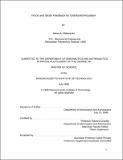| dc.contributor.advisor | Edward Crawley. | en_US |
| dc.contributor.author | Makarenko, Alexei A., 1969- | en_US |
| dc.date.accessioned | 2005-05-19T14:18:17Z | |
| dc.date.available | 2005-05-19T14:18:17Z | |
| dc.date.copyright | 1998 | en_US |
| dc.date.issued | 1998 | en_US |
| dc.identifier.uri | http://hdl.handle.net/1721.1/16712 | |
| dc.description | Thesis (S.M.)--Massachusetts Institute of Technology, Dept. of Aeronautics and Astronautics, 1998. | en_US |
| dc.description | Abstract in English and Russian. | en_US |
| dc.description | Includes bibliographical references (p. 149-152). | en_US |
| dc.description | This electronic version was submitted by the student author. The certified thesis is available in the Institute Archives and Special Collections. | en_US |
| dc.description.abstract | A method of shaping the open loop structural transfer function from a distributed sensor to a distributed actuator is developed. The outputs of two sensors of different impedances are combined electronically with the goal of increasing pole-zero spacing for improved performance in low-authority structural control loops. The concept of a three-element actuator- sensor module capable of adjusting the equivalent actuator and sensor impedances is presented. The module consists of an actuator, and two sensors for measuring force and strain. The output of the module is constructed by mixing the force and strain signals using a mixing coefficient which can be used to tune the apparent sensor impedance for maximum performance. General shape of zero trajectories as a function of the mixing coefficient is derived. Mass-spring and beam models are used to further explore the behavior of the zeroes of the mixed transfer function. Both an approximate beam model derived using assumed mode method and the exact solution of the beam vibration equation are employed. A practical implementation of the module is proposed. The design uses a piezoelectric actuator with a collocated piezoelectric strain sensor and a novel piezoelectric shear load cell. A test article was built, mounted on a cantilever aluminum beam, and tested. Experiments verified the ability to increase pole-zero separation of a structural transfer function by mixing the outputs of displacement and force sensors. At low frequencies the overall shape of experimentally found zero trajectories compared well to the results of beam models. Non-minimum phase zeroes encountered for certain values of the mixing coefficient in both the models and the experiments limit the range in which the mixed transfer function is attractive for feedback control. | en_US |
| dc.description.statementofresponsibility | by Alexei A. Makarenko. | en_US |
| dc.format.extent | 152 p. | en_US |
| dc.format.extent | 1848281 bytes | |
| dc.format.extent | 1847385 bytes | |
| dc.format.mimetype | application/pdf | |
| dc.format.mimetype | application/pdf | |
| dc.language | eng | en_US |
| dc.language.iso | eng | en_US |
| dc.publisher | Massachusetts Institute of Technology | en_US |
| dc.rights | M.I.T. theses are protected by copyright. They may be viewed from this source for any purpose, but reproduction or distribution in any format is prohibited without written permission. See provided URL for inquiries about permission. | en_US |
| dc.rights.uri | http://dspace.mit.edu/handle/1721.1/7582 | |
| dc.subject | Aeronautics and Astronautics | en_US |
| dc.title | Force and strain feedback for distributed actuation | en_US |
| dc.type | Thesis | en_US |
| dc.description.degree | S.M. | en_US |
| dc.contributor.department | Massachusetts Institute of Technology. Department of Aeronautics and Astronautics | en_US |
| dc.identifier.oclc | 42218140 | en_US |
